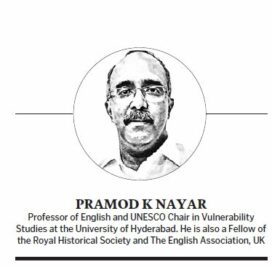
Opinion: End Verse, End-Times

Whether the world ends with a bang or a whimper, it will be an event without a witness
Publish Date – 12:45 AM , Fri – 24 Feb 23

Pramod K Nayyar
Hyderabad: In Wallace Stevens’ ‘Sunday Morning’, the protagonist feels ‘the darkness/encroachment of that old ruin’. The poem ends on a metaphor of mass extinction:
in the solitude of the sky,
Doves make random flocks at dusk
obscure waves as they sink,
On the extended wings, the underside is dark.
There’s a tenderness in Stevens’ ending with ‘vague ups and downs’ that stands in sharp contrast to TS Eliot’s declaration in ‘Hollow Men’: ‘This is the way the world ends / Not with a bang but with a whisper’ ‘.
Such poetry is the equivalent of an apocalyptic narrative about the end-times.
end times and verse
Arguably, one of the most popular representations of end-times is Lord Byron’s ‘Darkness’ (inspired by the 1815 Mount Tambora eruption in Indonesia, which changed weather patterns around the world), which portrayed a new ice age. does:
the bright sun was extinguished, and the stars
Darkness wandered in infinite space,
Railless, and trackless, and icy land
became blind and black in the moonlight air;
in this apocalyptic winter
the abode of all living things,
kindled for light; the cities were consumed,
and the men gathered around their flaming houses
To see each other’s face once again;
Human beings and other life forms are victims of this disaster:
vipers crawl
and joined the crowd,
Hissing, but without stinging – they are killed for food.
Even the dogs attacked their masters, save one,
And:
the world was empty
Was a populous and mighty lump,
Seasonless, Herbless, Treeless, Humanless, Lifeless –
A heap of death…
Byron ends with:
The winds were dry in the stagnant air,
And the cloud parted; there was no need for darkness
With his help – she was the universe.
If Byron speaks of a chilling end, so does Robert Frost:
i think i know a lot about hate
say destruction to the snow
also great
And that would be enough.
In WB Yeats’s ‘Second Coming’ ‘the stern beast bows to Bethlehem’, the beast of the Apocalypse.
In Czesław Miłosz’s ‘A Song for the End of the World’, it is a quiet ending:
the day the world ends
A bee circles the clover,
A fisherman mends a glimmering net.
happy scorpions jump into the sea
and ‘those who expected / are disappointed in the lightning and thunder’. so public
Can’t believe this is happening now.
As long as the sun and moon are up,
As long as the bumblebee approaches the rose,
until pink babies are born
No one believes this is happening now.
Often, end-time poetry employs the metaphor of emptiness/nothingness.
house but not home
In Robert Frost’s poem of the same title, a census taker arrives at a lonely house in the middle of nowhere. He finds that the house is ‘an emptiness very much filled with stone’. Confused, he searches the house: ‘No lamp was lit. There was nothing on the table/the stove was cold’. There are no people: ‘I did not see any man there nor any man’s bones there’. He wonders what to do about ‘the people who don’t live there’. His profession becomes redundant every year:
the sadness of counting souls
where they grow less and less every year
is extreme where they don’t shrink at all.
He concludes that, for his work at least, he needs life to go on: ‘It must be that I want life to go on’.
Walter de la Mare’s appropriately famous ‘The Listener’, begins with
‘is there anybody there?’ the traveler said,
knocking at the moonlight door;
de la mare says:
But no one got down to the traveler;
no head from the leaf-fringed threshold
bent down and looked into her brown eyes
But there is ‘a host of phantom listeners’ in the house, who ‘stood amid the faint moonlight on the dark staircase’. He finally leaves, and ‘silence slowly crept backwards’.
Langston Hughes finds emptiness in the ’empty house’: ‘In an empty house / I found an empty hell’. There is more woe in this empty house than in ‘the wide world’, says Hughes.
Such thought experiments can be read as an allegory of an Earth devoid of humans along the lines of Alan Weisman. the world without Us, Home is what will be with us when we are gone. Of course, one has to ask whether the ‘house’ itself is a metaphor for something, a legacy, perhaps. If there are survivors, what will they do with the vacant homes that are no longer homes? Who is the witness of what happens afterwards?
witness and prophet
absence of people does not mean absence life: because there are ghosts, spirits and other forms that are the witnesses of the end-times
In Wallace Stevens’ The Snowman, the snowman is the only witness to the splendor of winter, there being no human witnesses:
To the listener who listens in the snow,
and sees nothing
there is nothing that is not there and
Nothing like that.
Discerning Witnesses know that the end-times will not require, as Milos puts it, ‘lightning and thunder’. The world may end quietly:
only a white-haired old man who would be a prophet
Yet not a prophet, for he is too busy,
Repeats when he ties his tomatoes:
There will be no other end of the world,
There will be no other end of the world.
In Mary Oliver’s ‘I Found a Dead Fox’, the speaker sees a dead fox and lies down beside the body: ‘When I crawled / And lay down … and touched the dead fox’. Then
fox
disappeared.
There was only myself
and the world,
and it was me
who was going
what else could i sing
Then?
It is the human who disappears here.
From Byron to Milos and Oliver, poetry and end-times refer to death and dying, to empty houses and dark worlds, to the coming and going of species.
Perhaps the end of the world will be an event without witnesses.

